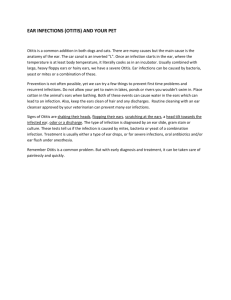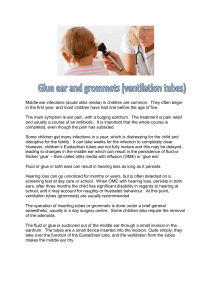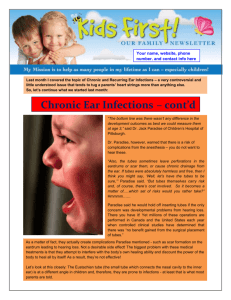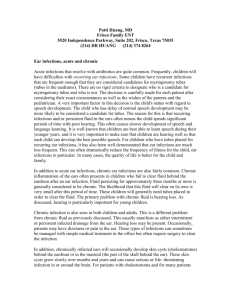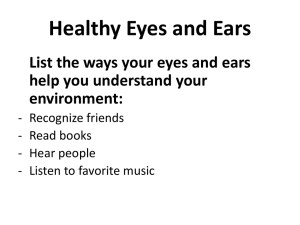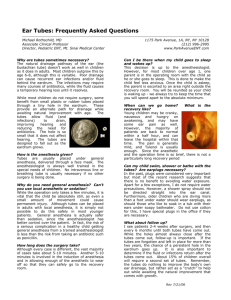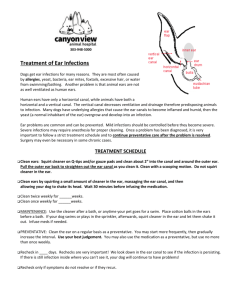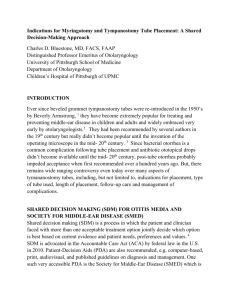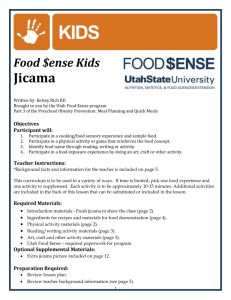115
advertisement
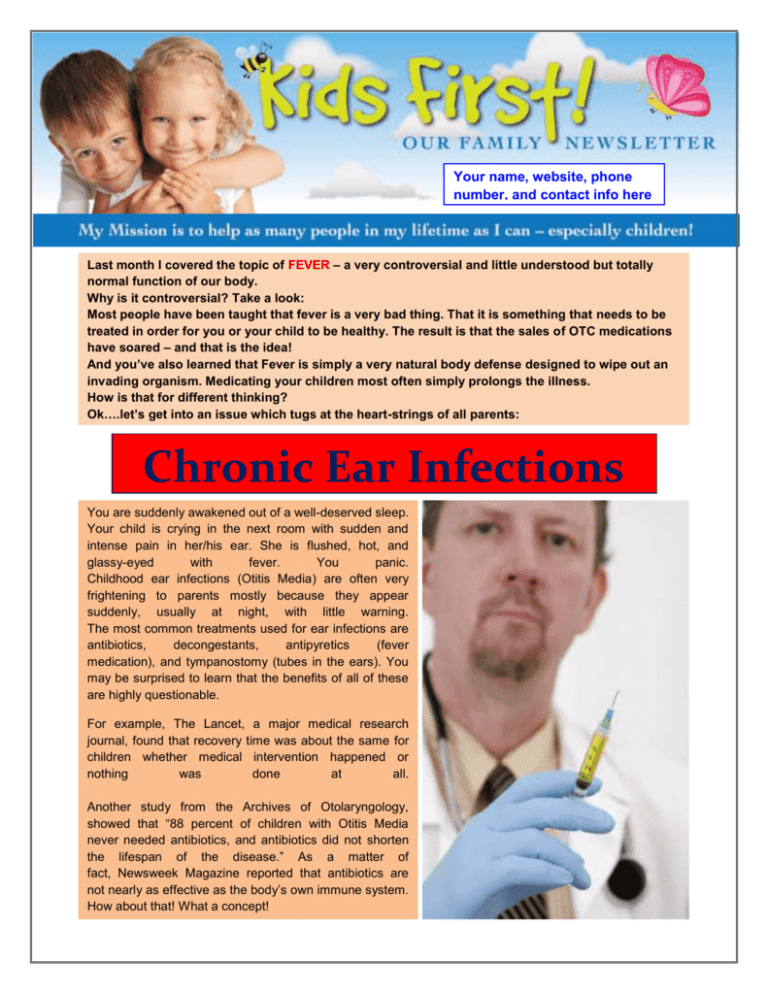
Your name, website, phone number, and contact info here Last month I covered the topic of FEVER – a very controversial and little understood but totally normal function of our body. Why is it controversial? Take a look: Most people have been taught that fever is a very bad thing. That it is something that needs to be treated in order for you or your child to be healthy. The result is that the sales of OTC medications have soared – and that is the idea! And you’ve also learned that Fever is simply a very natural body defense designed to wipe out an invading organism. Medicating your children most often simply prolongs the illness. How is that for different thinking? Ok….let’s get into an issue which tugs at the heart-strings of all parents: Chronic Ear Infections You are suddenly awakened out of a well-deserved sleep. Your child is crying in the next room with sudden and intense pain in her/his ear. She is flushed, hot, and glassy-eyed with fever. You panic. Childhood ear infections (Otitis Media) are often very frightening to parents mostly because they appear suddenly, usually at night, with little warning. The most common treatments used for ear infections are antibiotics, decongestants, antipyretics (fever medication), and tympanostomy (tubes in the ears). You may be surprised to learn that the benefits of all of these are highly questionable. For example, The Lancet, a major medical research journal, found that recovery time was about the same for children whether medical intervention happened or nothing was done at all. Another study from the Archives of Otolaryngology, showed that “88 percent of children with Otitis Media never needed antibiotics, and antibiotics did not shorten the lifespan of the disease.” As a matter of fact, Newsweek Magazine reported that antibiotics are not nearly as effective as the body’s own immune system. How about that! What a concept! For parents frustrated with recurring ear infections, the EENT (ear, eye, nose, and throat) specialist will most likely prescribe the “rite of tympanostomy”—words from the late Dr. Robert Mendelsohn, a pediatric specialist and a self- proclaimed “medical heretic.” It is a surgical procedure whereby your child is anesthetized so that a tube can be placed in his or her eardrum to drain fluid. Most people refer to this as simply “TUBES.” Research, however, indicates that this procedure does little to eliminate the problem. It simply reduces pressure and fluid build-up in the inner ear. It is no panacea for ear infections! Parents, however, have been sold on the idea that tubes in the ears are some kind of a cure for ear infections. Most mothers I meet in my office, whose children have chronic and recurring ear infections, have already had the “tube thing” done— with no success. And this whole concept of surgically placing “tubes” in the ears of young children to eliminate ear infections is absurd. The middle-ages come to mind! Perhaps The Rack is next? Whether or not to give a child tympanostomy tubes - tubes in the ears - is a debate that has raged in medicine for over two decades. One of the major arguments in favor of tubes is that if children have fluid behind the middle ear it can cut down on their ability to hear and can potentially lead to learning problems. But a report in the New England Journal of Medicine says this is not the case. According to this study, in children younger than three years of age who have persistent Otitis Media, prompt insertion of tympanostomy tubes does not measurably improve developmental outcomes. The procedure has little long-term effect with respect to hearing, behavior or learning development. Implanting ear tubes, an operation done on hundreds of thousands of toddlers each year, does not appear to improve their speech and learning development and may not be worth the risk and the cost, another study found. Researchers in Pittsburgh looked at two groups of toddlers: those who received ear tubes after three months of fluid in their ears (the standard guideline) and those who waited up to nine months before tubes were inserted. The children were tested for speech, language, learning, and behavior when they turned three. I’ll continue this train of thought in the next issue. Please stay with me! What the heck is Jicama? This slightly sweet and crunchy root vegetable may lack the marketing budgets of acai and coconut juice, but it acts as a pre-biotic to promote "friendly" bacteria in the gut. Plus it may boost collagen and fight wrinkles. Rich in vitamin C and minerals, Jicama, also known as Mexican yam or water chestnut, can be cooked, mashed, baked, or served raw in slaws, salads, and stir-fries, after you peel its thick skin. While predictions are swirling that Jicama will soon take an honorary place alongside carrots and kale, at this point you're still likely only to find the vegetable at farmers' markets or ethnic groceries. Jicama, like Jerusalem artichokes, is a source of inulin, a pre-biotic that can promote the growth of beneficial bacteria in the gut. Munching on Jicama might also boost the look of your skin, thanks to its vitamin C content (one cup of raw Jicama slices provides more than 24 mg of vitamin C). Eating vitamin C-rich foods can increase collagen production, which can help improve skin texture, speed wound healing, and give you a healthy glow. Still, Livestrong warns that while Jicama root is healthy and completely edible, the rest of the plant is toxic, including the seeds, leaves and pods. So…….please, be careful out there! Source: RelaxNews Variety is the spice of life – and your workout A well-rounded fitness program incorporates four areas of physical activity, according to Mayo Clinic experts. 1. Balance exercises. Besides improving balance, these help reduce the risk of falling. 2. Flexibility training. This helps joints move more easily. It also improves posture and balance, especially when flexibility and strength training are combined. 3. Strength training. This reduces the chances of heart attack and stroke. It also helps increase bone mass. 4. Aerobic activity. This helps reduce the risk of heart disease and stroke. It helps lower blood pressure, promotes healthy cholesterol levels, reduces risk of type 2 diabetes and can help improve stamina. Source: Mayo Clinic 100 Ways to live to 100: 53. Blood pressure reading Many factors can distort a BP reading by as much as 5 mmHg: acute exposure to cold, recent alcohol intake, incorrect arm position, an incorrect cuff size-and even the presence of the doctor, now so common that it’s called ‘white-coat’ hypertension. Blood pressure falls at night, and night-time blood pressure is considered the most accurate predictor of heart attack. Consider 24-hour blood-pressure monitoring, not the old-fashioned cuff. 54. Routine smear tests Many doctors still offer women an annual smear test for cervical cancer – even though they’ve been told the test can do more harm than good. The test throws up many false positives – incorrectly ‘seeing’ abnormal tissue that triggers a series of further and more invasive tests, plus needless worry. Even the NHS advises a smear test only once every three years for those aged over 21 and once every five years for those between 30 and 65. 55. Routine dental x-rays Your dentist keeps telling you it’s safer than an airplane flight, but dental X-rays could triple the risk of meningioma, a kind of brain tumour. Children who have a Panorex of full-mouth X-ray before the age of 10 run the greatest risk, and even bitewing X-rays increase risk. Regular exposure may also cause heart disease. Annual checkups should be urgently reconsidered, say Yale University researchers. 56. CT (computed tomography) scans This whole-body, three-dimensional imaging system is one of the most sensitive early-warning detectors of cancer, internal bleeding, heart problems, stroke and neurological disorders, but the standard course of two or three CT scans is equivalent to the radiation levels of Hiroshima or Nagasaki atomic bombs; just one scan is equivalent to around 500 standard chest X-rays, reckons the Royal College of Physicians of Edinburgh. 57. Routine prenatal ultrasound The prenatal ‘miracle’, which uses high-frequency pulsed sound waves to image the fetus in the womb, gets it wrong so often that up to one in 23 women told by doctors they’ve miscarried may end up terminating a healthy pregnancy. Scans often ‘see’ a miscarriage when the pregnancy is still viable, say researchers from London and Belgium. Reserve this for when something is really wrong, and consider waiting before ‘completing’ a termination if the test concludes you’ve miscarried. 58. Peripheral bone densitometry It’s the most commonly used diagnostic tool for osteoporosis, and it measures two sites, usually the hip and spine, but bone mineral density (BMD) is not uniform throughout the skeleton. Although the WHO criteria for a healthy BMD apply only to the hip and spine, a wide range of ‘normal’ BMDs elsewhere in the body may be misdiagnosed as abnormal by these criteria. Diagnosing osteoporosis is still not an exact science, say researchers; you have a strong chance of being misclassified, especially when the test is done in those under 65. I will continue this topic over the next issues until we reach 100 points. Please enjoy!

